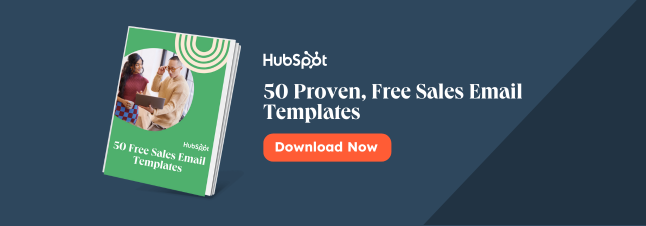My name is John Sherer and I spam my prospects. At least, I used to.
Unfortunately, I didn't stop mass email marketing until it stopped working. And, at that point, it's too late and you're left with no money.
![Download Now: 50 Sales Email Templates [Free Access]](https://no-cache.hubspot.com/cta/default/53/be67aa79-8dbe-4938-8256-fdf195247a9c.png)
So, today I'd like to share the evolution of my email prospecting strategy and how it went from old school robotic to modern and strategic, with a series of different email templates.
Want to skip straight to the SlideShare? No problem, click here.
What is mass email marketing?
Mass email marketing is when the same email is sent to a large subscriber list. It's a marketing strategy that isn't used much today as it usually yields a very low conversion rate.
Mass email is not customized, contains no personalized offers, and is sent to an unfiltered audience that may or may not be interested in what the sender has to say.
Today's consumers expect targeted and customized emails that use AI to provide information and offers relevant to their immediate needs.
How valuable is mass email marketing?
The main appeal of mass email marketing is its simplicity. You make one email template and send it out to your large subscriber list in minutes. It's a popular choice for sending content that doesn't warrant a response like a company announcement or newsletter. The overhead costs are also low, making it a user-friendly approach for small businesses that may not have the budget for a marketing team.
However, many of these messages land in spam folders. In order to get the most out of your email list and generate leads, personalization is key. For many consumers, email is their preferred way of interacting with a business. With 99% of consumers checking their email every day, it’s easy to see why email marketing is a powerful tool.
In the next section, we’ll examine how my mass email marketing campaigns fell short and how I worked to improve them.
The Old Mass Email Example
I used to mass email my leads three times a week, which generated enough appointments to consistently fill the top of my pipeline. The old mass email looked something like this:
Hi there,
Do you remember FAQ sections on websites? Occasionally you still see them, but for the most part, they've disappeared.
That's because a website's job is to answer a researcher or prospect's question. If you set up your website to answer your prospect's questions, you'll increase sales. Check out this New York Times article on why.
We offer a complimentary Website Content Assessment. When would be a good time to walk through your site?
Let me know what works best.
John

This mass email worked for two reasons:
1. It included a valuable piece of content.
I knew the New York Times article would grab many people's attention. While this email wasn't personalized — I did know that the prospects on my list would be interested in learning how their websites could answer prospect questions and save their reps time.
While it's obviously a mass email, this article made it interesting enough to grab my reader's attention for a second longer.
2. It included a request to connect.
To always be closing you must always be asking. You don't want to ask for your prospect's business in a mass email, but you do want to close for a connect call. Asking for a consultation regarding their site is a great way to pique interest in how I can help their business identify and fill gaps.So, this old mass email wasn't necessarily bad. But one day it stopped working, and I have a few hypotheses as to why:
1. The opener was too generic.
We all remember FAQs, but asking a generic opening question isn't offering anything of value to my prospects. They don't know why I'm asking them if they remember FAQ pages, and if I'm a busy marketer, I'm likely already zoning out and moving on to other emails.A better way to phrase this opening might have been, "The best way to increase your sales is to answer prospect questions. And the easiest way to do that is by optimizing your website."
I've immediately offered a piece of information that serves my prospect's business and should earn their attention.
2. Making assumptions about their website.
No one wants a random salesperson to insult their website — especially via a mass email. A better approach would be to research my prospect's website before sending a personalized email. Then, I could include one element I like about their site and an idea or two on what I would improve.
This is a less jarring way of offering help. It also provides immediate value to the prospect, without being pushy or offensive.
3. Making the prospect do all the work.
The least I could do here would be to link to a calendar or booking tool. Simply telling my prospects, "Let me know what works for you," is a vague, noncommittal way of asking for a follow-up.
A more proactive way to phrase this closing sentence would be, "I'd love to learn more about your website and its unique business challenges. Click here to book a free website content assessment: [Link to calendar]"
Whatever the cause, prospects stopped opening my emails — and that was a problem.
The "Personalized" Mass Email
As previously mentioned, mass email marketing has its place in some instances — like sending out a newsletter or announcement. For conversions and engagement, mass email won’t cut it. Email marketing needs to include personalization to extract its value. In response I made some small adjustments to the emails I was sending.
I tried a more personalized greeting and included a specific meeting time and date in my emails.
Hi there,
Do you remember FAQ sections on websites? Occasionally you still see them, but for the most part, they've disappeared.
That's because a website's job is to answer a researcher or prospect's question. If you set up your website to answer your prospect's questions, you'll increase sales. Check out this New York Times article on why.
Would you be able to talk at 2 p.m. ET on Wednesday?
Let me know what works best.
John

By now, you know what's coming: this still didn't work.
My attempt at sending “personalized” emails didn’t work because it’s still easy to see that my templates were still simply copied-and-pasted. Making one-word adjustments wasn’t enough.
Retiring Mass Email
Personalization goes beyond just adding a specific meeting time or a friendly greeting. Prospects want an email that’s tailored, focused, and adds value.
So, I threw out impersonal, ineffective mass emails and gave prospects what they wanted: a tailored message focused on solving their needs. Here's what that new email looked like:
Hello [First name],
You did an excellent job speaking at the recent 21st Century B2B Culture event. You have a great understanding of social business. Do you see social business being effective in B2C?
I had a few ideas on how it could work in B2C that are related to your recent book (which I read). I help B2C SMBs use the internet to bring their business to the national market.
What's the easiest way to get 10 minutes on your calendar Thursday to share how our market expertise can be mutually beneficial?
Best, John

I sent these emails one at a time — no more mass emails for me. And it worked. It still works. And here's why:
- I open with a custom event in the prospect's life
- I connect their expertise with my own
- I provide a specific timeframe to chat or provide an appointment link.
My prospecting emails started working again. It shouldn’t have been a surprise. More than 20% of marketers say personalization improves email engagement and 90% of US consumers find personalized marketing content appealing.
Collectively, our team tracked these emails to see which ones were opened. Then, we followed up immediately.
Now we don't have to robotically send mass emails. And we're not just filling the top of our pipelines. We're moving people through them.
Using a CRM will help you keep all of your contacts and prospects organized, streamlining your outreach efforts. If you’re already using HubSpot, take advantage of personalization tokens, which help you tailor your email template based on the recipient.
A Better Approach to Email Marketing
Creating tailored content takes more effort, but the ROI is worth it. So ditch mass emails and start giving prospects the personalized content that gets conversions.
This article was originally published in March 2019 and has been updated for comprehensiveness.
Email Prospecting





![The 18 Best Places for Sales Reps to Research Prospects [Expert Tips]](https://53.fs1.hubspotusercontent-na1.net/hubfs/53/Prospect%20Research%20(1).jpg)

.jpg)
![7 Intriguing Questions to Include in Your Prospecting Email [Infographic]](https://53.fs1.hubspotusercontent-na1.net/hubfs/53/00-Blog_Thinkstock_Images/questions-ask-prospect-email-compressor-976534-edited.jpg)